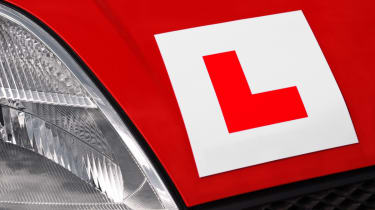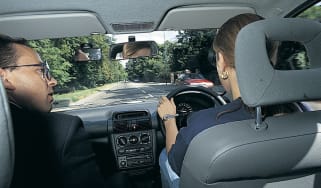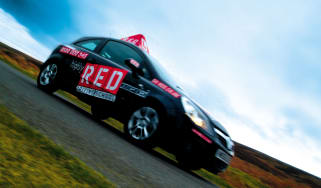How to pass your driving theory test
Practice makes perfect in the driving theory test, so get up to speed before you book your test online

Many learner drivers worry about their practical driving test, but there’s also a big hurdle to overcome first: the theory test. The driving theory test will require you to put in some hours of revision in order to score the pass mark. You’ll want to book your test as early as possible and give yourself plenty of time to prepare, including sitting some mock tests to familiarise yourself with the test. It will also be helpful to continue with your driving lessons so you can use this experience when answering the test questions.
Read on to find out how to pass your driving theory test on the first attempt, what mark you need to pass, our top tips to succeed and what happens next once you've aced it. It may also be worth viewing our guide on the perception test, too.
What is the driving theory test?
The UK driving theory test is the second step towards gaining your full driving licence after applying for and receiving your provisional licence. You must be 17 years of age before taking the test, although you sit it after your 16th birthday if you qualify for the Personal Independence Payment.
You will need to pass the theory test before you can book a practical examination, and it aims to test your knowledge of the Highway Code and driving in the UK. The questions are based on official Driving and Vehicle Standards Agency (DVSA) guides: The Official Highway Code, Know Your Traffic Signs and The Official DVSA Guide To Driving. Mock theory tests are a great way to learn what to expect, and these can be easily found online for free, including officially approved Government tests.
You must book in advance at an approved driving theory test centre. At the end of the test, you will receive your results and, if successful, a certificate valid for two years. If you do not pass your practical driving test within two years of passing, you will have to retake the theory test.
Booking your theory test
You can book a theory test by logging onto the Government’s online booking service (https://www.gov.uk/book-theory-test). To confirm the booking, you will need three things:
1. A valid provisional driving licence number
2. A credit or debit card to pay the fee required
3. An email address. If you don’t have one, you will have to book your test by phone.
To book a theory test over the phone, you can call the Driver and Vehicle Standards Agency on 0300 200 1122.
The driving theory test costs £23 to book. Unlike a driving test, the price is fixed and does not change if taken on an evening, weekend or bank holiday. If you fail your theory test, you can rebook at the same price.
When you arrive at the test centre, you will need to provide your provisional photocard driving licence. If you have a paper licence, you must also bring a valid passport to take the test. If you don’t bring these with you, you won't be able to take the test.
Driving theory test: how it works
The driving theory test is made up of two separate parts: the multiple-choice question section followed by the hazard perception test. Both tests need to be completed in one sitting on the same day, but you’ll be allowed to take a short break of up to three minutes between the two tests.
For the multiple-choice questionnaire, you will be given 50 questions about driving and safety on the roads, and you’ll need to pick from a series of different answers. These will focus on real-life situations drivers encounter out on the roads. It is best to familiarise yourself with the Highway Code for this part of the test and be sure to ask your driving instructor plenty of questions during your lessons to understand the best action to take in different scenarios.
For the hazard perception part of the test, you will be presented with 14 video clips taken from the perspective of a driver behind the wheel of a car out on the roads. The test will challenge you to identify all of the potential hazards that appear, such as cars emerging from junctions, pedestrians walking along the side of the road and passengers exiting their vehicles and opening the door onto the road. For more information on this part of the test, read our full guide on the hazard perception test.
It is worth spending some time working through mock driving theory tests before you sit the real thing, because being familiar with the structure of the test and understanding how it works will help you pass first time. By taking mock tests, you will gain an insight into the different types of questions you are likely to encounter on the day and have an opportunity to prepare your answer. Plenty of different mock tests are available online for free, so complete as many as possible before the big day if you want to be prepared.

Multiple-choice theory test pass mark
For the multiple-choice section of the driving theory test, you will be required to score at least 43 correct answers out of 50 questions. You’ll have 57 minutes to answer all the questions, which are randomly selected from a bank of nearly 1,000 questions – so we recommend covering a wide range of subjects in your preparation. You will be able to come back to any questions you have skipped at the end – just make sure you leave plenty of time to do so.
If you have a Safe Road User Award, an ‘abridged’ theory test can be taken. This costs £19 and requires the candidate to correctly pass 30 out of 35 questions.
Hazard perception test pass mark
After completing the multiple-choice part of the test, you’ll then be required the hazard perception test. To pass it, you will be required to score 44 out of a possible 75. The test will last for 20 minutes, and you won’t have the opportunity to go back and retry any questions at the end.
You will receive your scores at the end of the test, and if you’ve passed, you’ll also receive a certificate commemorating your successful completion.
Driving theory test: practice questions
Here are three example questions that represent what you can expect to find in the UK driving theory test, taken from an official online theory mock exam:
1. You get a puncture on the motorway. You manage to get your vehicle onto the hard shoulder. You should:
A. Only change the wheel if you have a passenger to help you.
B. Change the wheel yourself immediately.
C. Try to wave down another vehicle for help.
D. Use the emergency telephone and call for assistance.
2. You want to reverse into a side road. You are not sure that the area behind your car is clear. What should you do?
A. Check the mirrors only.
B. Carry on, assuming it is clear.
C. Look through the rear window only.
D. Get out and check.
3. You wish to park facing downhill. Which TWO of the following should you do?
A. Put the handbrake on firmly.
B. Park close to the bumper of another car.
C. Turn the steering wheel away from the kerb.
D. Park with two wheels on the kerb.
E. Turn the steering wheel towards the kerb.
In the test, you will be asked to select an answer. In some cases (as above), you will be required to choose more than one answer, which will be indicated to you clearly and in capital letters. Unlike the hazard perception test, you can skip questions you’re unsure of and come back to them once you’ve answered the rest.
Top tips to help you pass your theory test
- Book your test as early as possible
- Take at least one mock exam before the real thing
- Familiarise yourself with the Highway Code
- Be mindful of time limits during the test
- Read multiple-choice questions carefully
- Spot hazards when you’re out on the road
- Don’t forget your provisional licence!
What happens next?
Once you've passed the theory test, you're only a practical driving test away from a lifetime on the road. You can read our tips for the practical driving test to prepare yourself and pass the first time.
Once your tests are out of the way, the next step is the fun part, choosing your first car. Check out our list of the best first cars for new drivers to get off to the best start.
Find a car with the experts






